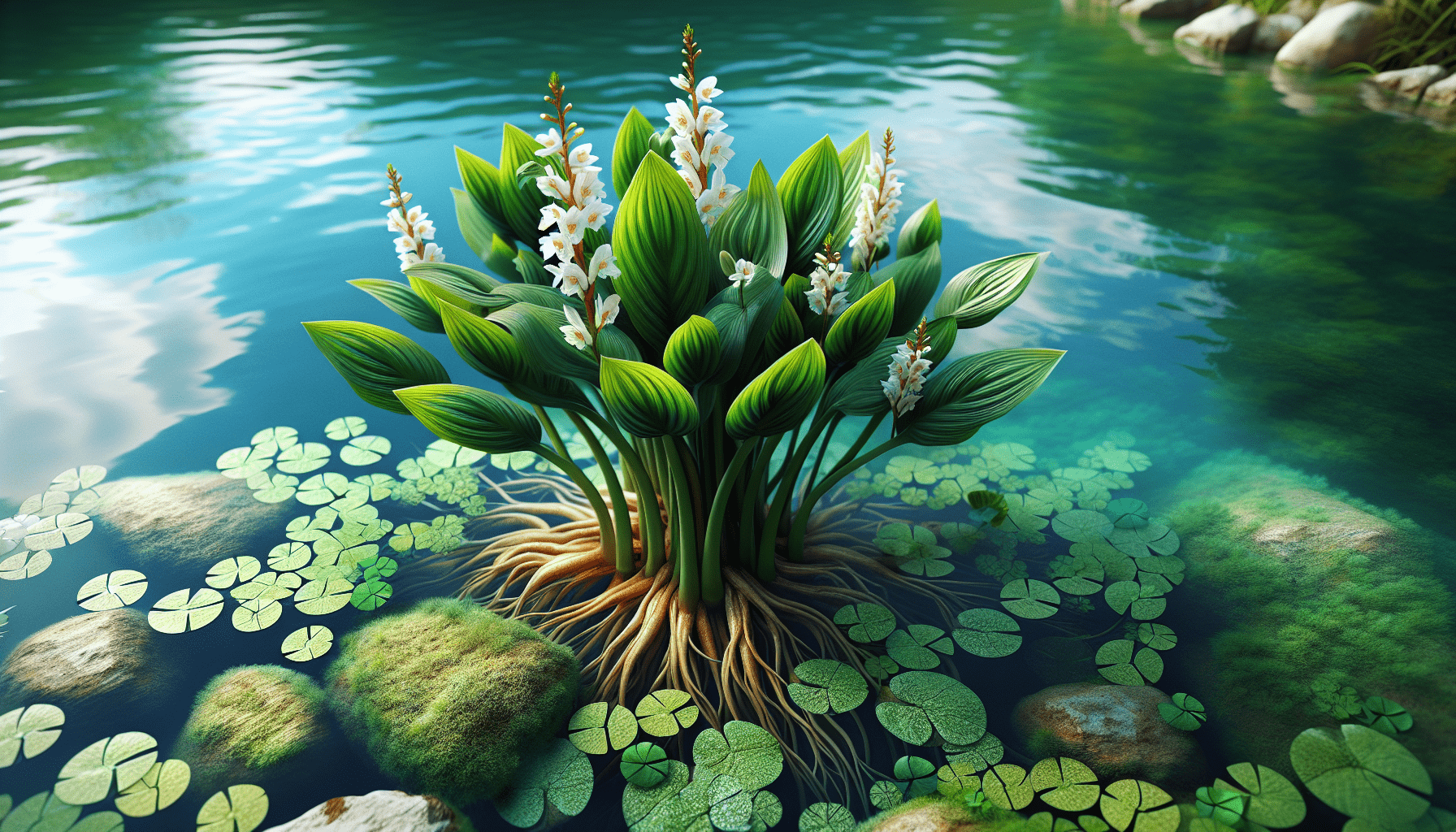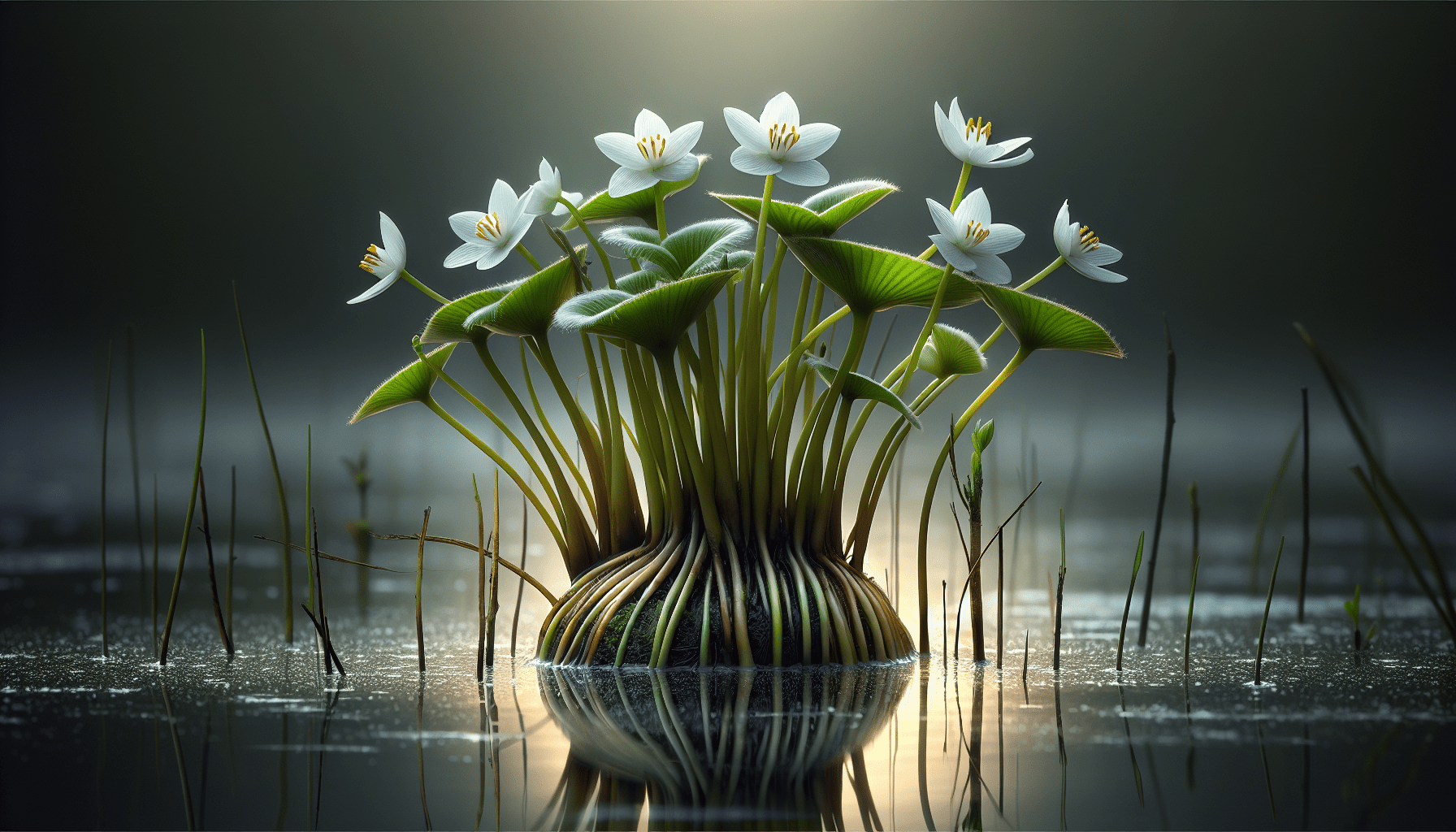As you traverse the intricate pathways of aquatic botany, you may come across the name Sagittaria Macrocarpa. This term encompasses more than mere syllables, as it bears the weight of an extensive narrative rooted in ecology. Sagittaria Macrocarpa, commonly known as a variety of duck potato, forms an integral part of the aqua flora landscape. This aquatic weed, despite its humble appearance, plays a critical role in the ecosystem it inhabits. This article will unfold the prolific attributes of Sagittaria Macrocarpa, elucidating its botanical traits, ecological significance and potential human uses, besides introducing its nuanced character within the broad realm of aquatic plant species.

Definition and Classification of Sagittaria Macrocarpa
This comprehensive article addresses the plant species Sagittaria Macrocarpa, an aquatic weed native to the wetlands of North America.
Species Identification
When it comes to species identification, Sagittaria Macrocarpa distinguishes itself as a peculiar arrowhead plant with distinct physical features and growing patterns. It’s referred by its binomial nomenclature Sagittaria Macrocarpa, a practice established by Carl Linnaeus to address species of plants universally under genus and species name.
Family and Genus Classification
Botanically, Sagittaria Macrocarpa belongs to the family Alismataceae, well known for its array of aquatic and semi-aquatic plants. Positioned under the genus Sagittaria, it captures the close association with its similarly classified siblings. The genus name Sagittaria is derived from the Latin term ‘sagitta’, suggesting ‘an arrow’, a fitting name for a plant whose leaves strongly suggest an arrowhead.
Common Names and Synonyms
As with many plants, the Sagittaria Macrocarpa has different common names and synonyms that vary by region. Some refer to it as large-fruited arrowhead, a name that accentuates the plant’s prominent fruit display. Other synonyms include Sagittaria platyphylla and Sagittaria variabilis, highlighting its variations in leaf shape and size.
Physical Characteristics of Sagittaria Macrocarpa
Addressing the botanical aspects of Sagittaria Macrocarpa requires a deep dive into its physical characteristics that define its identity in the plant kingdom.
Plant Structure
Sagittaria Macrocarpa presents a robust structure with a vertically upright growing habit. The plant stands tall with a leafless flowering stalk ascending from a perennial, tuberous rootstock.
Leaves Details
The most distinctive characteristic of Sagittaria Macrocarpa is its leaves. They are arrowhead-shaped as the genus name suggests and are typically a vibrant green color. They grow from the base of the plant, providing a dense coverage at the water surface.
Flowers Description
Adding to its striking physical allure are the plant’s flowers which display three white petals and are borne on a tall, leafless spike. Given the right conditions, Sagittaria Macrocarpa blooms generously throughout its growing season.
Seed Production and Dispersal
Sagittaria Macrocarpa produces plenty of seeds packed in a globulous fruit. These seeds play a significant role in the plant’s reproduction and spread, thanks to water currents dispersing them across aquatic environments.
Habitat and Geographic Distribution
Like every species, Sagittaria Macrocarpa has its preferred environments and geographical scope where it effortlessly thrives.
Natural Habitat Description
As an aquatic plant, Sagittaria Macrocarpa naturally adapts to water environments. You could find the plant gracing the shallow edges of rivers, lakes, and swamps, often in areas with still or slow-moving water.
Geographical Range and Distribution
Sagittaria Macrocarpa is native to the wetlands of North America, particularly in regions across northeastern United States and southeastern Canada. However, it has been introduced to various other regions globally, where it exhibits both beneficial and invasive tendencies.
Preferred Climatic and Water Conditions
The preferable climatic conditions for Sagittaria Macrocarpa include moderate to high rainfall and ambient temperatures. As for water conditions, Sagittaria Macrocarpa tends to prefer clean, shallow water bodies with a pH range of 6 to 8 but can adapt to varying water conditions.

Ecology of Sagittaria Macrocarpa
The bio-ecological aspects of Sagittaria Macrocarpa are as intriguing as its physical and botanical features, giving us an insight into its role, interactions, and impacts in the ecosystem.
Role in the Ecosystem
By producing a dense cover of leaves, Sagittaria Macrocarpa provides a habitat for numerous aquatic organisms. Its seeds and tubers serve as an important source of food for waterfowl, contributing to the ecosystem’s food chain.
Interaction with Other Species
Beyond its role in providing food and shelter, Sagittaria Macrocarpa’s robust growth can compete with other plant species for nutrients and space. In some environments, this competition can result in the displacement of native plant species.
Impact on Biodiversity
While Sagittaria Macrocarpa contributes to biodiversity by providing habitat and food sources, it may also pose a threat by overcrowding certain aquatic environments, causing a decrease in the diversity of native species. This discrepancy underscores the plant’s dual character as both a beneficial and potentially harmful component of an ecosystem.
Cultivation and Propagation of Sagittaria Macrocarpa
Cultivation and propagation of this aquatic plant involve understanding its ideal growth conditions, the methods utilized to propagate it, and the challenges faced during cultivation.
Ideal Growth Conditions
Sagittaria Macrocarpa thrives best in full sun to partial shade, with access to plenty of moisture. It is highly suited to waterfronts and water gardens where the water level is consistent.
Propagation Methods
Propagation of Sagittaria Macrocarpa can be done via seeds or tubers. Seeds planted just below the surface of the water or wet mud will sprout within a few weeks. Tubers can be divided and replanted in the spring.
Common Challenges in Cultivation
Cultivating Sagittaria Macrocarpa may encounter challenges owing to its invasive nature. Keeping it from overpopulating an area may require constant monitoring and manual removal. Additionally, it could potentially encroach on the growth of other plant species.
Uses of Sagittaria Macrocarpa
Despite being considered a weed, Sagittaria Macrocarpa has many uses, ranging from decorative to practical and commercial applications.
Use in Landscaping and Aquatic Gardening
Due to its lush growth and attractive flowers, Sagittaria Macrocarpa is commonly chosen as a feature in water gardens and ponds for landscaping purposes.
Use as Food or Medicine
The tubers of Sagittaria Macrocarpa can be consumed, and are traditionally used as a food source by some indigenous cultures. However, any medicinal uses are comparatively less known and may require further research.
Other Practical or Commercial Uses
In commercial uses, Sagittaria Macrocarpa is cultivated and sold as an aquarium plant due to its ability to adapt to varying water conditions and its attractive appearance.
Why Sagittaria Macrocarpa is Considered a Weed
Labeling Sagittaria Macrocarpa as a weed resonates with its invasive nature, the impact it can have on other species, and the associated control efforts.
Invasive Nature and Spread
The key reason why Sagittaria Macrocarpa is considered a weed is its potential to spread intensively across water bodies in a short period. Its seeds dispersed by water currents contribute to its aggressive spread.
Impact on Native Plant Species
When Sagittaria Macrocarpa establishes in a new water body, it can outcompete native plant species for space and nutrients and potentially displace them, altering the original ecosystem’s balance.
Efforts for Control and Eradication
Due to these impacts, human effort is required to control and eradicate overgrown populations of Sagittaria Macrocarpa. Such endeavors can be time-consuming, cost-intensive, and slow to result in restoring the affected ecosystems.
Prevention and Control Measures
Prevention and control of Sagittaria Macrocarpa call for proactive strategies aimed at curbing the invasive spread.
Preventive Methods
Preventive methods include monitoring new plant introductions in water bodies and minimizing the likelihood of seed dispersion by keeping the plant populations under control.
Chemical Control Options
Chemical control options often involve the use of aquatic-specific herbicides. However, these should be applied judiciously considering the potential effects on other non-target species and overall water quality.
Biological Control Mechanisms
Biological control mechanisms might include the introduction of species that feed on Sagittaria Macrocarpa or cause disease in the plant to naturally control its spread.
Impact of Sagittaria Macrocarpa on Aquatic Life
The presence of Sagittaria Macrocarpa in water bodies can profoundly influence aquatic life.
Effect on Water Quality and Clarity
On one hand, Sagittaria Macrocarpa can improve water quality by absorbing excess nutrients. However, overpopulation can lead to oxygen depletion during the night, thereby affecting the overall health of aquatic life.
Influence on Other Aquatic Organisms
Sagittaria Macrocarpa provides a habitat for small aquatic organisms and food for water birds. Yet, the dense foliage can also crowd out other plant species necessary for a balanced ecosystem.
Implications for Aquatic Ecosystems
In terms of broader implications, the invasive spread of Sagittaria Macrocarpa can alter aquatic ecosystems, impacting the diversity and abundance of both plant and animal species.
Research and Studies on Sagittaria Macrocarpa
Though ample information exists, Sagittaria Macrocarpa is still a subject of ongoing research.
Past and Ongoing Research
Past and ongoing research has mostly revolved around establishing the plant’s botanical characteristics, growth dynamics, and potential use. Experts have been grappling with understanding its invasive nature and devising ways to control its spread.
Important Findings and Discoveries
Significant discoveries include understanding its propagation methods, ideal growth conditions, beneficial role in the ecosystem, and the specific impacts it can have when occurring in high densities.
Areas for Future Study
Areas for future study include gaining more insight into its genetic constitution, the potential for biological control, the effects of chemical control on the environment, and further exploring its commercial uses.
By understanding the Sagittaria Macrocarpa in depth, one can truly appreciate its duality as a beautiful flower-bearing plant and a potential weed. It serves as an essential reminder that the manner in which we interact with our environment can tip the balance between sustaining biodiversity and triggering biological invasion.